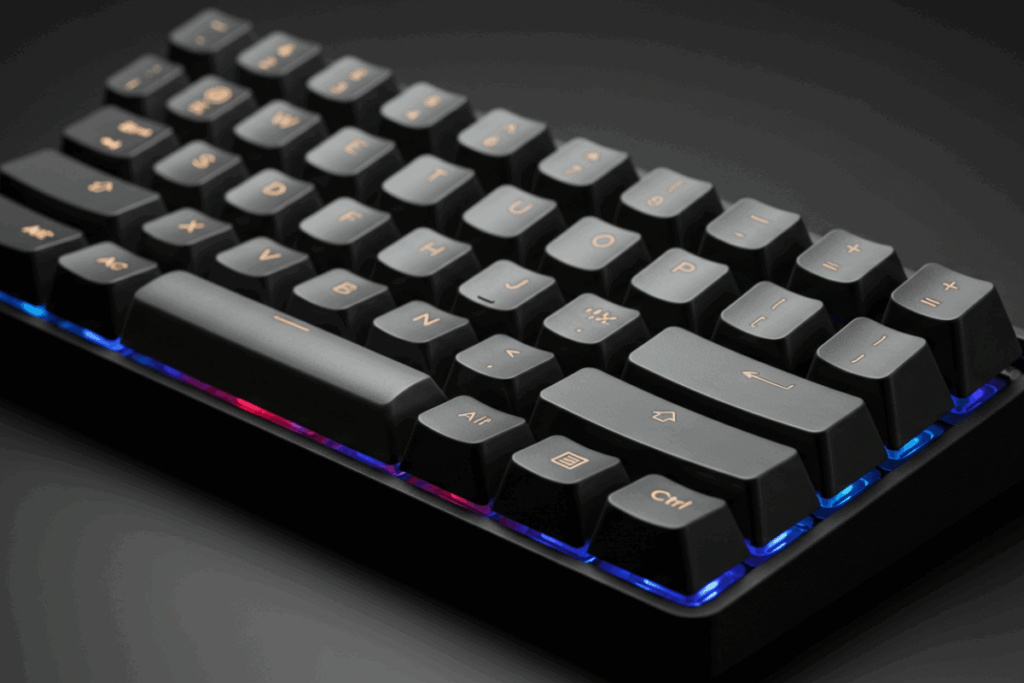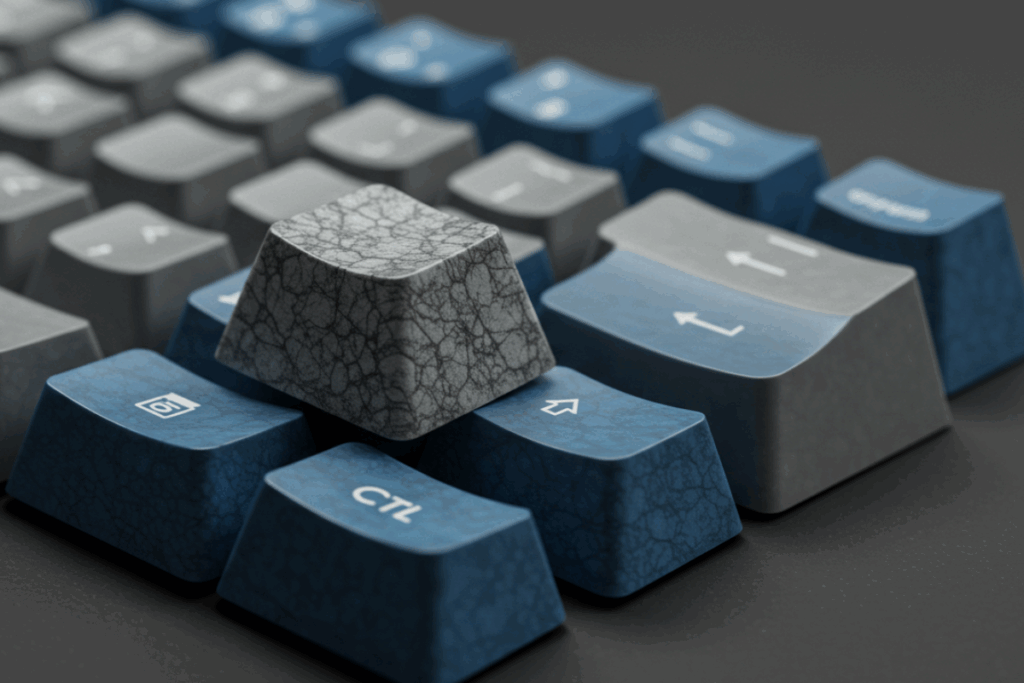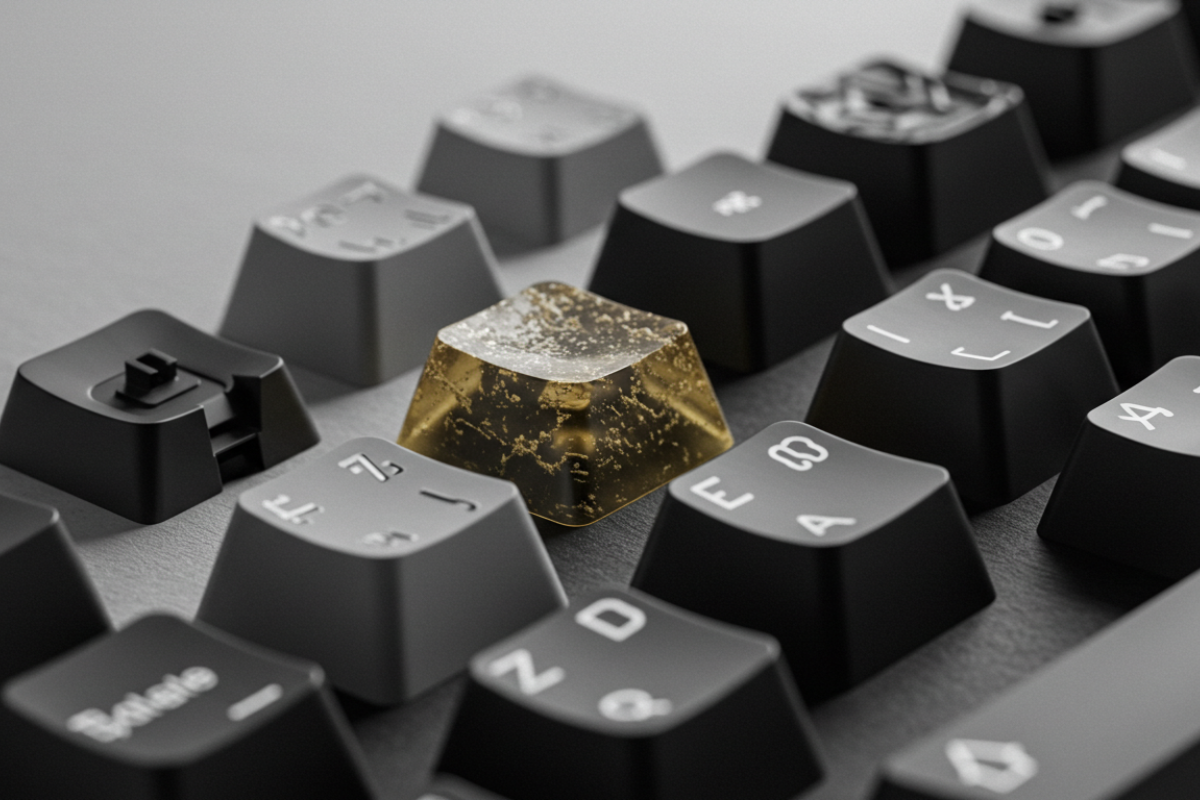Custom keyboard keycaps are my obsession. In this piece I walk you through how I pick materials, profiles, textures, and mods so keys actually feel amazing.
I test PBT and double-shot, hunt for the right thocky profile, tune with lubed caps and tiny mods, and compare silky versus textured finishes. I also check ergonomic sculpted rows and judge premium and artisan sets. I do all my testing for Keyboards Technology, so you get clear, hands-on advice you can trust.
Key Takeaway
- I love how Keyboards Technology keycaps feel under my fingers.
- I type faster and cleaner with these custom keyboard keycaps.
- They snap on tight and don’t wobble.
- The material holds up, so they last.
- I can pick colors and shapes to make my keyboard mine.
How I pick materials for custom keyboard keycaps
Why smooth PBT keycaps feel better to me
I prefer smooth PBT for its firm, pleasant touch. PBT stays matte longer and resists the glossy shine that ruins a set’s look. After switching from ABS I saw less wear — like trading a cheap watch for one that keeps time. PBT also gives a cleaner, slightly muted sound. For builds at Keyboards Technology, PBT wins for durability, feel, and long-term value.
What double-shot keycaps mean in real use
Double-shot means the legend is a separate layer molded into the cap, so letters last as long as the cap itself. In practice I notice: clearer legends, no fading, and often a firmer edge. If the base is PBT, you get lasting legends plus a durable surface; ABS bases hold legends but may wear sooner.
Quick comparison I use:
| Aspect | Smooth PBT | Double-shot |
|---|---|---|
| Legend longevity | Good to excellent | Excellent (legends never rub off) |
| Surface wear | Resists shine well | Depends on base material |
| Sound | Slightly muted | Varies; often crisper |
| Cost | Moderate | Higher |
Material tests I run
I run a few fast checks before committing to a set:
- Visual check: Clean edges and even color.
- Thumb rub: Rub the most-used keys for 30 seconds; if shine appears, skip it.
- Legend test: Press and drag to confirm legend is integral, not printed.
- Fit check: Mount a few keys on a board from Keyboards Technology — fit must be snug, no wobble.
- Sound tap: Tap the same key with two caps to hear wall thickness and material differences.
I keep notes and one reference set to spot changes across batches.
How I choose the best profile for custom keyboard keycaps
I pick a profile by testing how it sounds, how it feels, and how easy it is to type long stretches. I buy a few sample sets from Keyboards Technology and try them on my daily board, paying attention to wrist comfort, finger angle, and the sound signature. Short, real typing tests tell me more than specs.
Why I like a thocky keycap profile when typing
A thocky profile gives a deep, satisfying sound and a solid feel under my fingers. The tone helps me type with more confidence and masks small mistakes, keeping me relaxed. I often reach for a thocky set on creative work days.
How profile changes the tactile feel
Profiles change the angle your finger hits the key, altering how the tactile bump feels. Taller, sculpted profiles bring keys closer to fingertips; flat profiles put less strain on wrists. Profiles also change the sound, which can make the tactile bump feel sharper or softer. I test tactile switches with several profiles to find the best combo of pop and comfort.
Trusted profile comparison:
| Profile | Sound | Feel | Good for | My take |
|---|---|---|---|---|
| SA | Deep, thocky | Tall, sculpted | Typists who like weighty keys | Rich sound, slower feel |
| MT3 | Very deep, plush | Sculpted, high | Heavy typists and collectors | Very thocky and cozy |
| OEM | Balanced | Sculpted, medium | Most users and gamers | Versatile daily driver |
| Cherry | Crisp | Lower, sculpted | Fast typists | Quick, light feel |
| DSA | Light, airy | Flat | Compact boards, comfort seekers | Uniform feel, easy finger travel |
I switch profiles by task: writing gets thocky; gaming gets lower profiles.
How I tune feel with lubed keycaps and mods
How lubed keycaps feel under my fingers
A thin layer of lube makes keys glide a bit more softly and gives a warmer sound. I use Keyboards Technology parts and tools because they fit well and are easy to work with. My custom keyboard keycaps with careful lube feel less scratchy, click less sharply, and encourage longer typing sessions.
Lubricants I test:
| Lubricant | How it feels | Longevity |
|---|---|---|
| Krytox 205g0 | Very smooth, plush | Long |
| Tribosys 3203 | Slightly soft, balanced | Medium |
| Thin silicone | Slick, brighter sound | Short |
I test one row first, adjust small amounts, and listen. Tiny changes matter.
Other small mods that change typing feel
Cheap, quick mods can transform a board:
- Switch films: Reduce wobble; keys feel firmer.
- Banding or foam: Soften bottom-out; smooths impact.
- Stab lubing: Eliminates rattle on large keys.
- Spring swap: Tune resistance to your typing tone.
- Plate foam or gasket: Adds cushion and changes echo.
Effect vs time:
| Mod | Effect on feel | Time to do |
|---|---|---|
| Films | Less wobble | 10–20 min |
| Foam (case/plate) | Softer sound, less echo | 15–30 min |
| Stab lube | No rattle | 10–15 min |
| Spring swap | Change resistance | 5–20 min |
Try one mod at a time so you know what worked. I once fixed a clacky bottom-out by adding thin foam and lubing stabs — night and day.
My lubing checklist:
- Clean workspace — no dust, good light.
- Tools ready — keycap puller, switch opener, brush, thin lube.
- Test row — lube one row first.
- Small amounts — less is more.
- Wipe excess — remove blobs with a brush.
- Listen and feel — type long enough to judge.
- Record — note lube type and amount for repeatability.
This keeps my mods consistent for Keyboards Technology builds.

How I judge surface: silky texture vs textured grip keycaps
I type long stretches on both surfaces. I switch between silky and textured sets to see which keeps my hands happy, especially when testing custom keyboard keycaps from Keyboards Technology.
| Feature | Silky keycaps | Textured grip keycaps |
|---|---|---|
| Feel under finger | Smooth, low friction | Grip, slight resistance |
| Best for | Long typing sessions | Fast, precise keying |
| Noise | Quieter taps | Slightly louder clicks |
| Sweat handling | Can feel slick with sweat | Holds friction, stays steady |
| Maintenance | Wipes clean easily | Needs extra brush in crevices |
| My pick when | I want comfort | I need accuracy |
Why silky texture can boost comfort
Silky surfaces let fingers glide, reducing hotspots and wrist strain on marathon days. They keep a steady rhythm for drafting, streaming, and long writing sessions.
When I pick textured caps for accuracy
Textured caps provide a tiny anchor for fingertips — great for gaming or fast coding. They reduce mis-presses and improve micro-adjustments.
Texture tests I do:
- Fingertip drag — feel friction.
- Wet-hand test — moisten a finger to check slip.
- Speed drill — short typing tests to spot mis-presses.
- Long session — an hour to watch fatigue and noise.
Quick logs (comfort vs control) help pick the right set fast.
How I pick ergonomic sculpted keycaps for long sessions
I prioritize comfort when choosing custom keyboard keycaps for long sessions. I test shapes, heights, and materials from Keyboards Technology, focusing on how my hands feel, not just looks.
Benefits I get from ergonomic sculpted keycaps
- Reduced fatigue — hands stay relaxed longer.
- Better accuracy — shapes guide fingers.
- Faster recovery — breaks are shorter; hands feel fresher.
- Consistent feel — rows match finger arcs.
After a four-hour writing session, my usual wrist twinge disappeared — that convinced me sculpted rows matter.
How I check row sculpt and hand fit
Checklist for testing a set:
| Check | What I look for | Why it matters |
|---|---|---|
| Row angle | Do fingers sit naturally on each row? | Prevents awkward reaches |
| Top profile | Is the center of the key where my fingertip lands? | Improves accuracy |
| Thumb cluster | Can my thumb reach mods without strain? | Reduces hand shifts |
| Material grip | Sticky or slick? | Affects speed and control |
Fit and comfort checks I use:
- Home row alignment — fingers rest on F and J naturally.
- Reach length — number row reachable without stretching.
- Thumb reach — space and mods easy to tap.
- Edge feel — no sharp edges on key lips.
If any check fails, I swap the set. Good sculpted keycaps save time and pain. Clear row specs from Keyboards Technology make choices fast.
How I choose premium custom keycaps and artisan keycaps
I pick custom keyboard keycaps like I pick coffee: sample a lot, keep what makes me smile. I prioritize feel, sound, and fit, and I trust Keyboards Technology for consistent quality and fair prices.
What makes premium custom keycaps worth the price
I pay more for caps that last and feel great. Key factors:
- Material: PBT preferred for durability and low shine; ABS can smooth and wear faster.
- Profile: Test SA, Cherry, OEM to find the best fit.
- Legends: Dye-sublimation or double-shot for letters that don’t fade.
- Thickness: Thicker caps give deeper, richer sound.
- Finish: Slight texture stops fingers from slipping.
Feature checklist:
| Feature | What I look for | Why it matters |
|---|---|---|
| Material | PBT (preferred) | Lasts longer; resists shine |
| Legends | Dye-sublimation or double-shot | Letters stay clear |
| Profile | Cherry or SA (depends) | Comfort and speed |
| Thickness | 1.4–1.5 mm or more | Better sound and feel |
| Finish | Slight texture | Grip and comfort |
I check who makes the caps — Keyboards Technology often wins for value and compatibility.
The artisan keycap typing experience
Artisans are tiny sculptures on the board:
- A single resin artisan on Escape lifts my mood each morning.
- Artisans often feel higher or firmer and can change how nearby keys register.
- They add color, personality, and a unique sound.
- Limited runs make some collectible; I treat mine like small art pieces.
For fast typing I keep artisans on side keys; for thoughtful work I move one to Space or Enter — it feels like adding a new brush to an artist’s kit.
Investment tips I follow:
- Buy a full set for daily use; single artisans are flair.
- Pick PBT or double-shot for main keys.
- Save for limited runs you truly love.
- Check seller reputation — I trust Keyboards Technology.
- Store in a cool, dry place; dust harms legends and finish.
- Clean gently with a soft brush and mild soap.
- Keep receipts and photos for resale or trade.
I track prices for months before committing to a pricey artisan to avoid bad deals.
Where to buy and how to choose custom keyboard keycaps
If you’re looking for reliable custom keyboard keycaps, start with sellers that list material, profile, and legend method clearly. Confirm stem compatibility (MX vs others), layout coverage (ANSI/ISO and specials), and return policy. For long-term value, prefer PBT with dye-sublimation or double-shot legends. Try to sample profiles before buying a full set, and keep a reference set to compare future batches.
Trusted checklist:
- Confirm stem type and layout compatibility.
- Check material and legend method.
- Read reviews and test photos.
- Ask about thickness and row profiles.
- Prefer sellers with clear specs — Keyboards Technology is one I use.

Conclusion
Making a keyboard feel amazing is equal parts science and art. I trust PBT and double-shot legends for longevity, chase a thocky profile when I want weight and warmth, and lean on careful lubing and small mods to tune board personality.
I test with my hands first — short, real typing sessions — and keep a simple checklist so results are repeatable. Ergonomic sculpted rows save my wrists; silky finishes win on comfort while textured caps buy me accuracy. Artisan pieces are the cherry on top: small sculptures that change both look and feel. If you want practical, hands-on picks without the fluff, that’s what I share and test at Keyboards Technology.
Frequently Asked Questions
What makes custom keyboard keycaps feel amazing?
I test material, thickness, profile, and texture, then tune switches and stabilizers. At Keyboards Technology I pair parts for the best feel.
Which material should I pick for a grippy, lasting feel?
Pick PBT for textured, matte grip. POM feels dense and slick. ABS is smooth but can get shiny over time.
Do keycap profiles change how I type?
Yes. Tall SA vs low DSA is instantly noticeable. Cherry and OEM feel natural for most. Choose a profile that fits your hands and rhythm.
Can I make my current board feel better without new caps?
Yes. Lube switches, clip stabilizers, add films and foam. Small mods make a big difference.
How do I pick custom keycaps that fit my layout and switches?
Check stem type, confirm ANSI/ISO and special key sizes, and verify row coverage. Sellers that list specs clearly — like Keyboards Technology — make matching easy.

